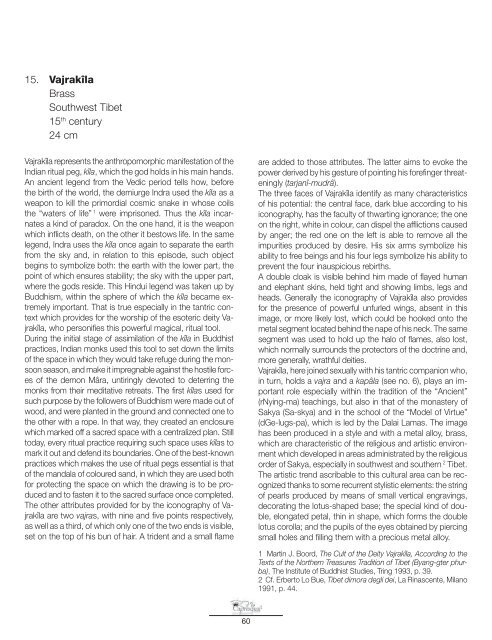Images of Devotion - capriaquar.it
Images of Devotion - capriaquar.it
Images of Devotion - capriaquar.it
Create successful ePaper yourself
Turn your PDF publications into a flip-book with our unique Google optimized e-Paper software.
15. Vajrakîla<br />
Brass<br />
Southwest Tibet<br />
15 th century<br />
24 cm<br />
Vajrakîla represents the anthropomorphic manifestation <strong>of</strong> the<br />
Indian r<strong>it</strong>ual peg, kîla, which the god holds in his main hands.<br />
An ancient legend from the Vedic period tells how, before<br />
the birth <strong>of</strong> the world, the demiurge Indra used the kîla as a<br />
weapon to kill the primordial cosmic snake in whose coils<br />
the “waters <strong>of</strong> life” 1 were imprisoned. Thus the kîla incarnates<br />
a kind <strong>of</strong> paradox. On the one hand, <strong>it</strong> is the weapon<br />
which inflicts death, on the other <strong>it</strong> bestows life. In the same<br />
legend, Indra uses the kîla once again to separate the earth<br />
from the sky and, in relation to this episode, such object<br />
begins to symbolize both: the earth w<strong>it</strong>h the lower part, the<br />
point <strong>of</strong> which ensures stabil<strong>it</strong>y; the sky w<strong>it</strong>h the upper part,<br />
where the gods reside. This Hindui legend was taken up by<br />
Buddhism, w<strong>it</strong>hin the sphere <strong>of</strong> which the kîla became extremely<br />
important. That is true especially in the tantric context<br />
which provides for the worship <strong>of</strong> the esoteric de<strong>it</strong>y Vajrakîla,<br />
who personifies this powerful magical, r<strong>it</strong>ual tool.<br />
During the in<strong>it</strong>ial stage <strong>of</strong> assimilation <strong>of</strong> the kîla in Buddhist<br />
practices, Indian monks used this tool to set down the lim<strong>it</strong>s<br />
<strong>of</strong> the space in which they would take refuge during the monsoon<br />
season, and make <strong>it</strong> impregnable against the hostile forces<br />
<strong>of</strong> the demon Mâra, untiringly devoted to deterring the<br />
monks from their med<strong>it</strong>ative retreats. The first kîlas used for<br />
such purpose by the followers <strong>of</strong> Buddhism were made out <strong>of</strong><br />
wood, and were planted in the ground and connected one to<br />
the other w<strong>it</strong>h a rope. In that way, they created an enclosure<br />
which marked <strong>of</strong>f a sacred space w<strong>it</strong>h a centralized plan. Still<br />
today, every r<strong>it</strong>ual practice requiring such space uses kîlas to<br />
mark <strong>it</strong> out and defend <strong>it</strong>s boundaries. One <strong>of</strong> the best-known<br />
practices which makes the use <strong>of</strong> r<strong>it</strong>ual pegs essential is that<br />
<strong>of</strong> the mandala <strong>of</strong> coloured sand, in which they are used both<br />
for protecting the space on which the drawing is to be produced<br />
and to fasten <strong>it</strong> to the sacred surface once completed.<br />
The other attributes provided for by the iconography <strong>of</strong> Vajrakîla<br />
are two vajras, w<strong>it</strong>h nine and five points respectively,<br />
as well as a third, <strong>of</strong> which only one <strong>of</strong> the two ends is visible,<br />
set on the top <strong>of</strong> his bun <strong>of</strong> hair. A trident and a small flame<br />
60<br />
are added to those attributes. The latter aims to evoke the<br />
power derived by his gesture <strong>of</strong> pointing his forefinger threateningly<br />
(tarjanî-mudrâ).<br />
The three faces <strong>of</strong> Vajrakîla identify as many characteristics<br />
<strong>of</strong> his potential: the central face, dark blue according to his<br />
iconography, has the faculty <strong>of</strong> thwarting ignorance; the one<br />
on the right, wh<strong>it</strong>e in colour, can dispel the afflictions caused<br />
by anger; the red one on the left is able to remove all the<br />
impur<strong>it</strong>ies produced by desire. His six arms symbolize his<br />
abil<strong>it</strong>y to free beings and his four legs symbolize his abil<strong>it</strong>y to<br />
prevent the four inauspicious rebirths.<br />
A double cloak is visible behind him made <strong>of</strong> flayed human<br />
and elephant skins, held tight and showing limbs, legs and<br />
heads. Generally the iconography <strong>of</strong> Vajrakîla also provides<br />
for the presence <strong>of</strong> powerful unfurled wings, absent in this<br />
image, or more likely lost, which could be hooked onto the<br />
metal segment located behind the nape <strong>of</strong> his neck. The same<br />
segment was used to hold up the halo <strong>of</strong> flames, also lost,<br />
which normally surrounds the protectors <strong>of</strong> the doctrine and,<br />
more generally, wrathful de<strong>it</strong>ies.<br />
Vajrakîla, here joined sexually w<strong>it</strong>h his tantric companion who,<br />
in turn, holds a vajra and a kapâla (see no. 6), plays an important<br />
role especially w<strong>it</strong>hin the trad<strong>it</strong>ion <strong>of</strong> the “Ancient”<br />
(rNying-ma) teachings, but also in that <strong>of</strong> the monastery <strong>of</strong><br />
Sakya (Sa-skya) and in the school <strong>of</strong> the “Model <strong>of</strong> Virtue”<br />
(dGe-lugs-pa), which is led by the Dalai Lamas. The image<br />
has been produced in a style and w<strong>it</strong>h a metal alloy, brass,<br />
which are characteristic <strong>of</strong> the religious and artistic environment<br />
which developed in areas administrated by the religious<br />
order <strong>of</strong> Sakya, especially in southwest and southern 2 Tibet.<br />
The artistic trend ascribable to this cultural area can be recognized<br />
thanks to some recurrent stylistic elements: the string<br />
<strong>of</strong> pearls produced by means <strong>of</strong> small vertical engravings,<br />
decorating the lotus-shaped base; the special kind <strong>of</strong> double,<br />
elongated petal, thin in shape, which forms the double<br />
lotus corolla; and the pupils <strong>of</strong> the eyes obtained by piercing<br />
small holes and filling them w<strong>it</strong>h a precious metal alloy.<br />
1 Martin J. Boord, The Cult <strong>of</strong> the De<strong>it</strong>y Vajrakîla, According to the<br />
Texts <strong>of</strong> the Northern Treasures Trad<strong>it</strong>ion <strong>of</strong> Tibet (Byang-gter phurba),<br />
The Inst<strong>it</strong>ute <strong>of</strong> Buddhist Studies, Tring 1993, p. 39.<br />
2 Cf. Erberto Lo Bue, Tibet dimora degli dei, La Rinascente, Milano<br />
1991, p. 44.


